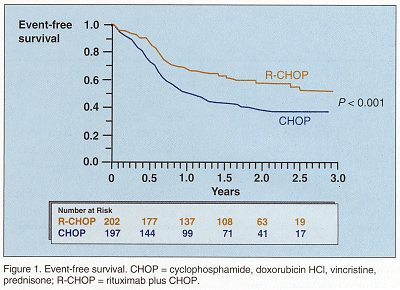R-CHOP Benefits Increase Over Time for Aggressive Large B-Cell Lymphomas in Elderly
LYON, France-A year after he presented interim data indicating that R-CHOP produced better results than CHOP alone against aggressive B-cell lymphomas in the elderly, Bertrand Coiffier, MD, reported that the benefits of the combination of rituximab (Rituxan) plus CHOP (cyclophosphamide [Cytoxan, Neosar], doxorubicin HCl, vincristine [Oncovin], prednisone) increased over time.
LYON, FranceA year after he presented interim data indicating that R-CHOP produced better results than CHOP alone against aggressive B-cell lymphomas in the elderly, Bertrand Coiffier, MD, reported that the benefits of the combination of rituximab (Rituxan) plus CHOP (cyclophosphamide [Cytoxan, Neosar], doxorubicin HCl, vincristine [Oncovin], prednisone) increased over time.
"We observed a better outcome for every parameter," Dr. Coiffier said at the 43rd Annual Meeting of the American Society of Hematology (ASH). "CHOP plus rituximab increased response rate, decreased relapse, increased event-free survival and overall survival, and produced no more toxicity than classical CHOP."
Interim Results of ‘Landmark Study’
The phase III Groupe d’Etude des Lymphoma de l’Adulte (GELA) study was heralded as a "landmark study" at last year’s ASH meeting. Interim results at 12-months follow-up allowed Dr. Coiffier to predict then that R-CHOP "may be the new standard for treatment of aggressive B-cell lymphomas in elderly patients." Two-year results presented by Dr. Coiffier this year confirmed R-CHOP’s benefit for elderly patients. Dr. Coiffier also indicated that R-CHOP might be useful for younger patients, but that supporting data are needed.
The GELA study randomized patients to two different armseither standard CHOP every 3 weeks for eight cycles or standard CHOP plus rituximab at 375 mg/m² on day 1 of each cycle. In order to be eligible for the study, patients had to be 60 to 80 years old and have diffuse large B-cell lymphoma (DLCL). "Only 40% of the patients had a good prognosis according to the International Prognostic Index," Dr. Coiffier reported, with the remaining 60% considered poor risk.
The interim analysis included 328 patients with a median follow-up of 12 months. An update at a median follow-up of 18 months included age-adjusted data on 399 patients, and Dr. Coiffier presented results at a median of 2 years follow-up.
Response and Toxicity Data
Complete response to treatment increased slightly for both arms and remained statistically significant at 63% for the CHOP arm and 76% for the R-CHOP arm. "Overall survival results are also better than last year," Dr. Coiffier reported, "and at 2 years the difference is 13%57% vs 70%."
Eventsdefined as disease progression, death without progression, and alternative new treatmentoccurred in 61% of CHOP patients vs 43% of R-CHOP patients. Progression during treatment was considerably more common among CHOP patients (22%) compared to R-CHOP (9%), as was relapse25% vs 14%. "The results for event-free survival in fact improved with time," Dr. Coiffier said, "rising to 57% in the R-CHOP arm. Now at 2 years, the difference between the two arms is 20%, not 15%." (See Figure 1.)

Dr. Coiffier reported "little difference in toxicity between the two arms." Maximum toxicity occurred after the first infusion, with 10% of R-CHOP patients experiencing some grade 3 to 4 infusion-related events. "What is important is the fact that none of these patients died of the infusion-related toxicity," Dr. Coiffier said, "and all continued to be treated."
Overall, slightly more deaths occurred in the R-CHOP arm. At least some of these deaths, however, could be attributed to elderly patients dying of other causes, according to Dr. Coiffier.
Implications for the Future
The trial confirmed the benefits of combining rituximab and CHOP for elderly patients with DLCL. The benefits extended to both good- and poor-risk patients and to those younger or older than 70 years.
In another presentation at the ASH meeting, Michael Pfreundschuh, MD, reported results showing that six cycles of CHOP at 2-week intervals should be the new standard regimen for patients over 60 years old with aggressive NHL (see "New Standards Proposed for Treating Aggressive NHLAge a Factor"). Dr. Pfreundschuh called for new trials comparing 2-weekly CHOP with or without rituximab.
R-CHOP may also be used for even younger patients in the future as a first-line defense or at relapse, Dr. Coiffier said. He stressed, however, that there are as yet no supporting data to say that R-CHOP is better than chemotherapy alone for these patients, or that it should be used in the treatment of all patients with B-cell lymphoma.